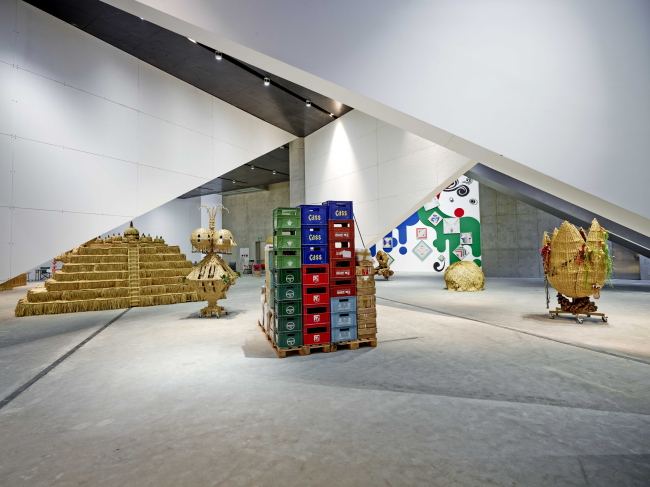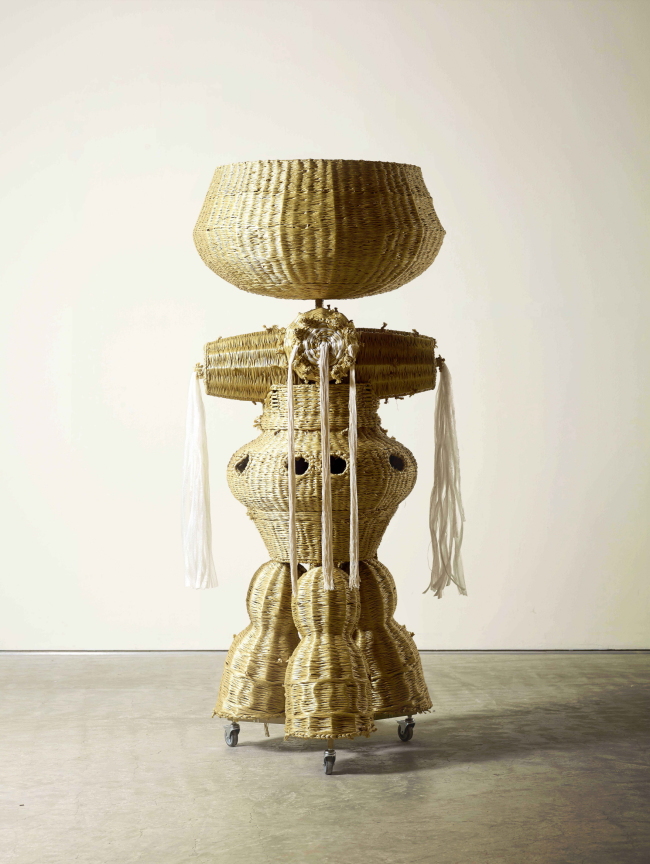Pondering the big questions
Artist Yang Haegue’s semi retrospective explores men vs. nature, individuals vs. society
By Lee Woo-youngPublished : Feb. 24, 2015 - 19:51
A huge banner reading “Shooting the Elephant/Thinking the Elephant” greets visitors to artist Yang Haegue’s solo exhibition at Leeum, Samsung Museum of Art.
Inside, however, there is nothing even remotely resembling the mammal. The elephant is the artist’s metaphor for a typical, yet profound question about men and nature.
In her semi retrospective and third solo exhibit in Korea, Yang explores the relationship between the two.
Inside, however, there is nothing even remotely resembling the mammal. The elephant is the artist’s metaphor for a typical, yet profound question about men and nature.
In her semi retrospective and third solo exhibit in Korea, Yang explores the relationship between the two.

The allegory in the exhibition title is derived from two literary works: “Shooting an Elephant” by George Orwell and “The Roots of Heaven” by Romain Gary. In both books, the elephant is the subject of human exploitation and at the same time makes humans realize the significance of nature and its power.
“The stories embedded in the exhibition title and artworks are really grand. I have frequently had doubts myself if I really need to bring such an ambitious topic at my age,” Yang, 44, said at the press preview on Feb. 9.
She expressed concerns that the theme may sound “too grand” for an artist in the 40s to present to the world.
Yet, it was the bold approach to grand questions that won the Seoul-born artist recognition in the global art scene.
Yang, who moved to Berlin in 1994, has been better known in Europe with conceptual installations that address relations between individuals and community since the mid-2000s.
The artist has held more exhibitions overseas than in Korea.

She was featured in major international art showcases such as Venice Biennale and Kassel Documenta. She represented the Korea Pavilion at Venice Biennale in 2009, which in turn introduced her to the Korean art world.
The ongoing exhibition at Leeum is a broad survey of her 20 years of career in art, with her earlier and recent works on display.
Her respect for nature is clear in the latest series “The Intermediates,” which are artificial straw sculptures built in the shapes of the ancient Mayan pyramid, the Indonesian Buddhist temple Borobudur and the Russian Islamic mosque Lala Tulpan.
Straw became the artist’s newest inspiration after she saw trees covered with straws one cold winter in the Japanese province of Kanazawa.
She was intrigued by the continued use of straws in the industrialized society and the centuries-old straw craft-making skills that have passed down from generation to generation.
“Straw is used to recover indigenous characteristics in human beings and highlights anthropological value of straw craft,” explained Tae Hyun-sun, curator of the exhibition.
The straw installations are mingled with her past works, including “Storage Piece” (2004), “VIP’s Union” (2001/2005) and “Seoul Guts” (2010).
The works are not organized in a chronological order to enable viewers to travel through different phases of the artist.
“Storage Piece” ― a pile of boxes enclosed with Yang’s earlier works ― signifies the turning point in Yang’s artistic career.
Yang, then a yet-to-be discovered artist, had little storage space for her works. So before trashing them, she decided to give them one last chance to be viewed in public. She had the artworks shipped to the gallery, presented them just the way they arrived and collectively named it “Storage Piece.”
Critics took it as a bold attempt to mock the art world and started to pay attention to Yang. A German collector bought the piece.
The “Storage Piece” was introduced at the 28th Sao Paulo Biennale in 2006 and is still one of Yang’s most acclaimed works.
“VIP Union” turns a corner of the exhibition hall into a resting area, displaying tables and chairs owned by business leaders, cultural figures and celebrities, including T.O.P of the mega-hit K-pop group Big Bang. The work reflects the artist’s principle of basing her art on the stories of communities and society.
“Seoul Guts” is a tribute to Seoulites. Common objects that can be found in everyday life of the citizens are assembled on clothing racks. The items include cellphone accessories and makeup tools which show people’s obsession with good looks, and cleaning brushes, shower sponges, laundry balls and a sink strainer that represent their devotion to hygiene.
The exhibition continues through May 10 at Leeum, Samsung Museum of Art, in Seoul. Admission is 7,000 won for adults and 4,000 won for students. An English guided tour is available at 2 p.m. on Saturday and Sunday. For more information, call (02) 2014-6901.
By Lee Woo-young (wylee@heraldcorp.com)





![[Herald Interview] 'Amid aging population, Korea to invite more young professionals from overseas'](http://res.heraldm.com/phpwas/restmb_idxmake.php?idx=644&simg=/content/image/2024/04/24/20240424050844_0.jpg&u=20240424200058)











![[KH Explains] Korean shipbuilding stocks rally: Real growth or bubble?](http://res.heraldm.com/phpwas/restmb_idxmake.php?idx=652&simg=/content/image/2024/04/25/20240425050656_0.jpg&u=)

